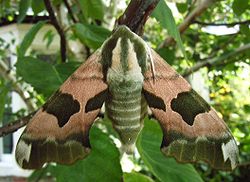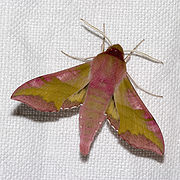.gif)
List of moths of Great Britain (Sphingidae)
Encyclopedia
The family
Sphingidae
comprises the "Hawk-moths", of which seventeen occur regularly in Great Britain
:
Subfamily Sphinginae

Subfamily Smerinthinae


Species listed in the 2007 UK Biodiversity Action Plan
(BAP) are indicated by a double-dagger symbol (‡)—species so listed for research purposes only are also indicated with an asterisk (‡*).
Family (biology)
In biological classification, family is* a taxonomic rank. Other well-known ranks are life, domain, kingdom, phylum, class, order, genus, and species, with family fitting between order and genus. As for the other well-known ranks, there is the option of an immediately lower rank, indicated by the...
Sphingidae
Sphingidae
Sphingidae is a family of moths , commonly known as hawk moths, sphinx moths and hornworms, that includes about 1,200 species . It is best represented in the tropics but there are species in every region . They are moderate to large in size and are distinguished among moths for their rapid,...
comprises the "Hawk-moths", of which seventeen occur regularly in Great Britain
Great Britain
Great Britain or Britain is an island situated to the northwest of Continental Europe. It is the ninth largest island in the world, and the largest European island, as well as the largest of the British Isles...
:
Subfamily SphinginaeSphinginaeThe Sphinginae are a subfamily of the hawkmoths , moths of the order Lepidoptera. Notable taxa include the Pink-Spotted Hawkmoth, Agrius cingulata, being a very common and recognizable species, the death's-head hawkmoths of Silence of the Lambs fame, and Xanthopan morgani with its enormous...

-
[ Agrius cingulataAgrius cingulataThe Pink-spotted Hawkmoth or Sweetpotato Hornworm is a species of moth in the Sphingidae family. The imagines have a wingspan of 3 3/4 - 4 3/4 inches . They have a robust gray brown body with pink bands, hence the name. Their abdomen tapers to a point. The hindwings are gray with black bands and...
Pink-spotted Hawk-moth — probable import] - Agrius convolvuliAgrius convolvuliThe Convolvulus Hawk-moth, Agrius convolvuli, is a large hawkmoth. It is common throughout Europe, Africa and Australia.-Description and habits:The wingspan is 80-105 mm...
Convolvulus Hawk-moth — migrant - Acherontia atroposAcherontia atroposAcherontia atropos is the most widely-known of the three species of Death's-head Hawk moth. Acherontia species are notorious mainly for a vaguely skull-shaped pattern on the thorax.-Appearance:...
Death's-head Hawk-moth — migrant -
[ Manduca quinquemaculata Five-spotted Hawk-moth — probable import] -
[ Manduca sexta Tomato Sphinx — probable import] -
[ Manduca rusticaManduca rusticaThe Rustic Sphinx is a moth of the Sphingidae family. It is found in the southern parts of the United States , southward through Mexico, Central America and South America to Uruguay....
Rustic Sphinx — probable import] - Sphinx ligustri Privet Hawk-moth — south
-
[ Sphinx drupiferarumSphinx drupiferarumThe Wild Cherry Sphinx is a moth of the Sphingidae family. It is found from the temperate parts of the United States to southern Canada....
Wild Cherry Sphinx — possible migrant, more likely import] - Hyloicus pinastri Pine Hawk-moth — south and south-east (localized)
Subfamily SmerinthinaeSmerinthinaeThe Smerinthinae are a sub-family of Sphingidae moths in the order Lepidoptera.-Smerinthinae Taxonomy:*Tribe Ambulycini*Tribe Smerinthini*Tribe Sphingulini- References :*, All-Leps Barcode of Life...

- Mimas tiliae Lime Hawk-moth — south and centre
- Smerinthus ocellataSmerinthus ocellataSmerinthus ocellata, known as the Eyed Hawk-Moth, is a European moth of the family Sphingidae.The eyespots are not visible in resting position, where the forewings cover them...
Eyed Hawk-moth — south and centre - Laothoe populi Poplar Hawk-moth — throughout
Subfamily Macroglossinae

- Hemaris tityusHemaris tityusHemaris tityus, the Narrow-bordered Bee Hawk-moth, is one of two similar species of sphingid moth occurring in Britain that closely mimic a bumblebee. It has a wide range, from Ireland across temperate Europe to the Ural Mountains, western Siberia, Novosibirsk and the Altai...
Narrow-bordered Bee Hawkmoth — south-west, west-central, north-west and east (Nationally Scarce B) ‡ - Hemaris fuciformisHemaris fuciformisHemaris fuciformis, known as the Broad-bordered Bee Hawk-moth, is a moth of the family Sphingidae. It is found in North Africa, Europe and Central and Eastern Asia.The wingspan is...
Broad-bordered Bee Hawkmoth — south and east-central (Nationally Scarce B) - Macroglossum stellatarum Hummingbird Hawk-moth — common migrant, resident in south-west
- Proserpinus proserpina Willowherb Hawk-moth — south and east (may be accidental import)
- Daphnis neriiDaphnis neriiDaphnis nerii , known as the Oleander Hawk-moth, is a moth of the Sphingidae family.-Distribution:Daphnis nerii is a large hawk-moth found in wide areas of Africa and Asia...
Oleander Hawk-moth — migrant - Hyles euphorbiaeHyles euphorbiaeThe Spurge Hawk-moth is a European moth of the family Sphingidae. This hawk moth is used as an agent of biological pest control against the noxious weed known as leafy spurge , but usually only in conjunction with other agents...
Spurge Hawk-moth — migrant - Hyles galliiHyles galliiThe Bedstraw Hawk-Moth or Gallium Sphinx is a moth of the family Sphingidae. It is found in North America, Europe, Central Asia and Japan....
Bedstraw Hawk-moth — migrant (occasionally over-winters) -
[ Hyles nicaeaHyles nicaeaThe Mediterranean Hawk-moth is a moth of the Sphingidae family. The nominate subspecies is found from southern Portugal and Spain though southern Europe to Turkey. It is also found on the Balearic Islands and in south-western Bulgaria....
Mediterranean Hawk-moth — possible migrant, more likely import] -
[ Hyles hippophaesHyles hippophaesHyles hippophaes is a species of moth in the Sphingidae family. It is found in Afghanistan, Armenia, Azerbaijan, China, France, Georgia, Germany, Greece, Iran, Iraq, Kazakhstan, Kyrgyzstan, Mongolia, Pakistan, Romania, Serbia and Montenegro, Spain, Switzerland, Syria, Tajikistan, Turkey,...
Seathorn Hawk-moth — possible migrant, more likely import] - Hyles livornicaHyles livornicaThe Striped Hawk-moth is a moth of the family Sphingidae. It is found in Africa, Southern Europe and Central and East Asia and Poland. Hyles renneri from Nepal is sometimes treated as a valid species.The wingspan is 60-80 mm...
Striped Hawk-moth — migrant - Hyles lineataHyles lineataThe White-lined sphinx is a moth of the Sphingidae family. It lives from Central America, through the United States and into parts of Canada.-Description:...
White-lined Hawk-moth — ?vagrantVagrancy (biology)Vagrancy is a phenomenon in biology whereby individual animals appear well outside their normal range; individual animals which exhibit vagrancy are known as vagrants. The term accidental is sometimes also used... - Deilephila elpenor Elephant Hawk-moth — south and centre (common), north (rare)
- Deilephila porcellusDeilephila porcellusDeilephila porcellus, known as the Small Elephant Hawk-moth, is a moth of the family Sphingidae. It is found in Europe, North Africa and Western Asia.The wingspan is . The moth flies from May to July depending on the location....
Small Elephant Hawk-moth — south, centre and north (localized) - Hippotion celerioHippotion celerioHippotion celerio, known as the Vine Hawk-Moth or Silver-striped Hawk-Moth, is a moth of the Sphingidae family. It is found in Africa, Southern Europe, Central and Southern Asia and Australia. It can be found further north, because of its migratory nature.-Colouring and marks :The body and forewing...
Silver-striped Hawk-moth — migrant
Species listed in the 2007 UK Biodiversity Action Plan
United Kingdom Biodiversity Action Plan
The United Kingdom Biodiversity Action Plan is the governmental response to the Convention on Biological Diversity signed in 1992. When the Biodiversity Action Plans were first published in 1994, the conservation of 391 species and 45 habitats was covered. 1,150 species and 65 habitats are...
(BAP) are indicated by a double-dagger symbol (‡)—species so listed for research purposes only are also indicated with an asterisk (‡*).

